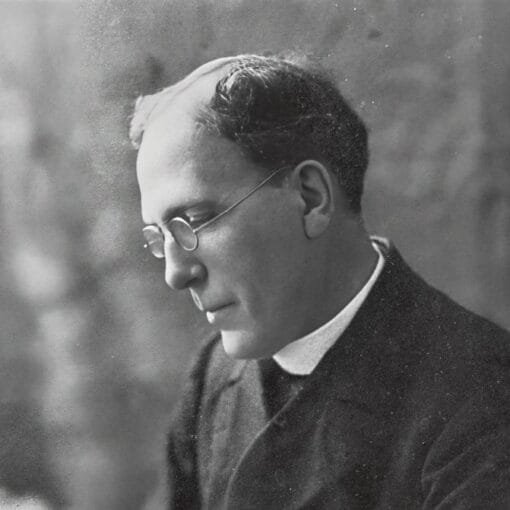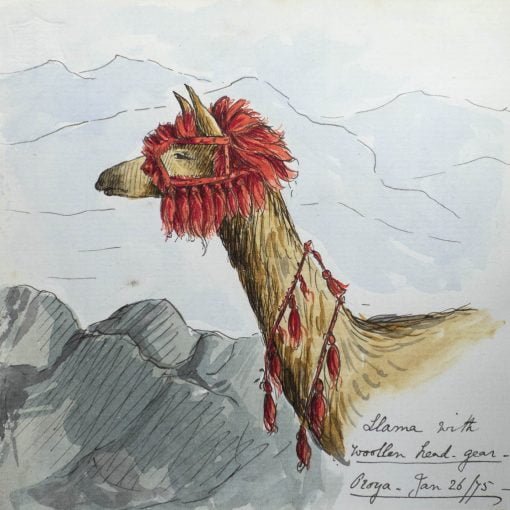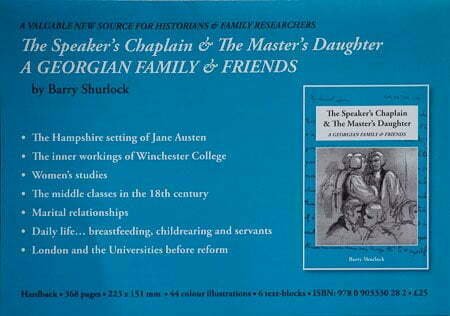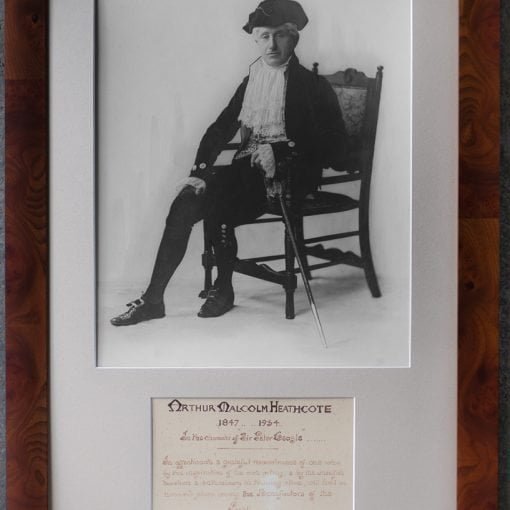
Table of Contents
The Old School at Silkstead
Part 1 – From the Compton Parish Magazine June 1938
The hamlet of Silkstead, lying midway between Hursley and Otterbourne and well away from main roads, offers today no indication of any unusual antiquarian interest. Apart from a certain number of old squared stones built into the brickwork of cottage walls there is nothing which suggests a date earlier than the Stuart period.
The legend, which has found its way into several books on Hampshire, that there was once a monastery there, is incorrect ; but the place did have a very special connection with the great Priory of St. Swithun at Winchester, of whose estates it formed a part.
It was in the Silkstead fields that the Priory, far in advance of its times, tried out (before extending it elsewhere) the then novel experiment of farming with a small permanent staff of paid labourers, instead of relying on the forced and spasmodic efforts of a host of villein tenants — an agricultural revolution of the first order.
It was in the walled Court-farm there, with its Chapel and Great Hall, that a long succession of Priors, accompanied by their not inconsiderable retinues, were wont to seek relaxation from the cares of their high office.
And it was here (as we learn from 116 pre-Reformation account rolls) that from time to time they dispensed a hospitality based on sucking-pigs, and fortified very adequately with geese, capons and pigeons.
There is reason to think that the famous Thomas Silkstede (Prior of St. Swithun’s 1498-1524) was born here, that his real name was Harries, and that — following a common practice — he assumed the name of his native place when he entered religion.
Our present concern however is not with the palmy mediaeval days but with a Roman Catholic school conducted there, in the atmosphere of semi-secrecy which the time necessitated, during the latter part of the 17th century.
In the early 1680’s the old Court-farm had passed away and there stood in its place, but occupying a much smaller site, a brick farmhouse ; much altered and now divided into four cottages it stands there still. A hundred yards to the north-east stood the Manor House, a three-storied brick house built by Prior Silkstede — little thinking that the days of the monastery were nearly numbered — as a country residence for the Priors of St. Swithun’s. Elsewhere in the hamlet were two or three little farmsteads occupied by families of the small yeoman class. The Manor House and the farm were held on lease from the Dean and Chapter of Winchester by Taverner Harris, a grandson of a former Warden of Winchester College. This young man lived on his estate in Oxfordshire and he had sublet the Manor House to a papist gentleman, Philip Taylor.
There was in Silkstead a strong Roman Catholic tradition. After the Reformation a number of the little community had clung to the old Faith with a steadfastness in sharp contrast to the complaisance with which the monks of St. Swithun’s themselves had accepted the new regime. Nor had 150 years of minor persecution extinguished this little colony. It is not suggested that they had to endure the heavy fines and confiscations of property which often fell to the lot of their richer co-religionists–they were not sufficiently well off for that. But in the periodical anti-papist drives Silkstead stalwarts figure regularly in the lists of Quarter Sessions indictments. A Roman Catholic mission had been working in Winchester all through the days of the intensive persecutions of priests, and there can be no doubt that, to the mission, Silkstead and its people had always been very well known.
About this time the High Command of the Roman Church in England was considering the possibility of establishing, in various parts of the country, schools (under the direction of priests) for the education of the sons of the papist gentry. The project was full of danger. Only three or four years before some 2000 papists had been thrown into prison — and a number executed — at the instigation of Titus Oates. True, the latter was now discredited, but popular feeling in London was fundamentally anti-papist and another persecution might be engineered at any moment ; and a school is not easy to conceal.
At Silkstead however the conditions were exceptionally favourable. Accommodation was available at the Manor, where Philip Taylor and his wife were living alone — they had no children — in a house containing eight bedrooms and six attics. Moreover, Philip had a relation (possibly his brother), Augustine Taylor, who had been for some years a priest on the Winchester mission ; with Augustine as schoolmaster the arrangement might be expected to work smoothly. Lastly, Silkstead was remote from the public eye, and the religious tradition of the place would provide a sympathetic environment, and reduce the danger of trouble in time of stress.
There is no direct evidence of the date when the school was opened. A Roman Catholic historian suggests 1688, on the ground that James II. (himself a papist) had by then rendered the position of his co-religionists more secure. And certainly several other schools, in London and elsewhere, were opened about that year. But on this point a clue — for what it is worth — comes from the Winchester Probate Registry. Philip Taylor died in 1684, and attached to his will is a room-by-room inventory of the Manor, dated September 3rd of that year. This shows that although, as we have seen, Philip’s household was a small one, the house contained no less than 26 bedsteads. Without pressing the point too far it seems a possible inference that, if the pupils had not already arrived, the house was at least being prepared for their reception.
However this may be, by the summer of 1688 the school needed an assistant master. The choice fell on Thomas Brown, a Yorkshireman who had been trained at the English seminary at Douai, and who went also by the name of Weatherby. These alternative names had been of course extremely common, and indeed often necessary, in the days when the hangman’s rope was seldom very far from the priest’s neck.
Mr. Brown was working ill the north at the time, and on August 12th the well-known Bishop Leyburn applied to the Vicar Apostolic of the Northern District for his services. His very guarded letter is typical of papist correspondence of the period and shows the care that had to be taken lest it should fall into the wrong hands. “ We look upon him,” wrote the Bishop, “ as one verie proper and indeed necessarie to assist a friend of ours who hath employment for him near Winchester……. I need not tell you how much it imports that a fitt person be not wanting in that place, and especially since he for whom an assistant is desired doth not enjoy a strong habit of health.”
In the following December came the Revolution, and in the storm which then swept James II. from the throne the papist schools went down like ninepins. Silkstead escaped almost alone ; perhaps its very remoteness, or the fact that its pupils included sons of influential men, saved it from destruction. At all events Augustine Taylor was left to continue his work unmolested. (To be concluded).
The Old School at Silkstead. (concluded).
Part 2 – From the Compton Parish Magazine July 1938
Within a year or two Augustine Taylor’s health broke down and he retired to Winchester, where in 1692 he died. He was replaced as headmaster by another of the mission priests, William Husband (alias Bernard). Like Mr. Brown, he was a Yorkshireman, educated at Douai. What their own religious superiors thought of these Silkstead priests may be judged from a report made on them in 1692 for the information of the “Old Chapter of England.”
“ Mr. Augustine Taylor, a Roman [i.e. educated at the English College in Rome] hath been in the mission I believe above 20 years, hath taken great pains both in the school at Silkstead and in the mission, now is much exhausted by sickness. He resides mostly at Winchester.
“ Mr. William Bernard (vere Husband), of Doway, hath been in the mission about 11 or 12 years and with great applause and public benefit governs the schoole at Silkstead near Winchester.
“ Mr. Brown, of Doway, of not long standing in the mission, a person of very good parts, coadjutor to Mr. Bernard.”
There were no further changes in the staff until the beginning of 1696 when a young priest, Edward Taverner, alias John Banister, came straight from the English College at Valladolid to Silkstead. He replaced Thomas Brown, who was transferred later to London.
There has come down to us a detailed count of the rules and customs of the school. It dates from a somewhat later period, but it probably gives a very fair idea of the daily round at Silkstead at the time we were considering.
The pupils rose at 6 in the summer (6.30 in the winter) and dressed. Coming downstairs they washed their hands, faces and mouths, and the housemaids combed their hair. After Morning Prayers, read “ leisurely and distinctly ” by selected boys, came breakfast, consisting of bread and butter, broth, milk or milk-pottage.
Mass followed, on the days when it was said, and then all went to the schoolroom, where each morning, Work began with catechism from the “ Doway Abstract and Instructions for Children.” Other studies followed, the last hour being always devoted to writing or ciphering. In cold weather there was a fire in the schoolroom, but those who had greatcoats or nightgowns were permitted also to wear them.
Dinner was at noon ; the food is not specified, but it is noted that boys who wished for fruit had to pay for it out of their own pocket — so little does scholastic England change. There was recreation until 2 o’clock, when Evening Prayers were said, the master being careful to see that the boys “ do not huddle over their prayers, as they are too apt to do.” School work then went on until 6, when there was supper of bread and butter or bread and cheese, with apple tart as an occasional treat. Then recreation until Night Prayers at 8, and so, after Examination of Conscience and Reflection for the Day, to bed “ without ramping, noise, or running into each other’s Chambers.”
On Sundays more time was naturally devoted to religious duties, but there was plenty of play too. It is laid down however that “ Recreation allow’d on Sundays ought only to be such as Protestants are not likely to be offended at, as they generally are at Nine-Pins, Cricket, drawing the Cart about, etc.”
For the rest, they were encouraged to cultivate little gardens of their own, but were forbidden to climb trees, eat unripe fruit or dig holes in the playground. Baths are not mentioned, but feet were to be washed “ once a month or thereabouts.”
And so things went on quietly, if not altogether hygienically, until early in 1696. Then quite suddenly the blow fell. On February 14th a Jacobite plot to assassinate King William III. on his way from Kensington to Richmond was disclosed to the Government.
After a short interval there followed an attack of that mild hysteria which used so often to afflict Authority when plots were in the wind. On the 24th the lords-lieutenant of all English counties were ordered to seize papists’ horses ; those of Essex, Kent, Sussex, Hants, Suffolk, Norfolk, Lancashire and Cheshire were further instructed to raise the militia horse; the militia officers, assisted by the constables were to search for and seize all papists and their arms.
This panicky order could not be carried out in its entirety — there were far too many papists for that.
But in the midst of all the hubbub somebody remembered Silkstead. What could be more menacing to the realm than this score of small boys learning their Doway Abstract? Here, if anywhere, stern action was required.
Exactly what happened we shall probably never know, for a year or two later a fire at the Privy Council office destroyed a great quantity of their contemporary documents. There survive, however, copies of two letters from the Privy Council to the Duke of Bolton’ lord-lieutenant of Hampshire. The first, dated March 7th, acknowledges the Duke’s report that “ the Schoolmaster and other men ” had been seized, and gives instructions for their prosecution. The second followed on March 28th.
“ Whereas by our letter of the 7th of this inst. March. Wee did pray and require your Grace to give directions for committing to the County Gaol the Schoolmaster and other men of the Popish School at Silkstead near Winchester, but that the Boyes should be permitted to go to their respective homes. Wee pray and require your Grace to give directions that the Boys of the said School be permitted to remain there for fifteen days Except they shall be taken from thence by their Parents in that time, and afterwards to cause such of the said Boyes as shall remain there to be sent to their next of kin being Protestants respectively.”
But — and this is rather an anticlimax — it would seem that, when once the school had been dispersed, no further action was taken against the staff. Neither the Quarter Sessions records nor the Gaol Delivery of the next Assizes contain any entry relating to the affair. It looks therefore as if Authority, having recovered its composure, had decided that in this case a mountain was being made out of a molehill, and had quietly released the accused.
But the Silkstead days were over. It may be that, to save the face of Authority a change of locality and of headmaster was the price of permission to re-open the school. At all events Mr. Bernard returned to the mission, and the school was re-constituted that same autumn two miles away at Twyford under Mr. Taverner. The future poet, Alexander Pope, was one of the first pupils there.
The rest of the story is soon told. The school carried on at Twyford for nearly 50 years — Mr. Taverner was headmaster till 1725 — and at one time had over 100 boarders. In 1745, as a result of the “ No Popery ” agitation which followed Prince Charlie’s invasion, it was dissolved. Not for four years was it possible to re-open, but in 1749 the school was re-established at Standon Lordship, Hertfordshire. In that county it still flourishes, in an altered form, as St. Edmund’s College, Old Hall Green.
At Silkstead, the Manor House was pulled down a century ago. A depression in the field marks the site of its cellar, and in times of drought the brown grass over the wall-foundations still shows clearly the ground-plan of the sometime school.
J. S. DREW.
Reprinted from “ The Hampshire Chronicle.”
Editor’s notes
- These two articles on “The Old School at Silkstead” later appeared as Appendix D of J.S.Drew’s book “Compton near Winchester”, published by Warren & Son in 1939.
- See also “Twyford School, An Illustrated History”, by Roger Porteous and John Stott, published 2010 by George Mann Publications. The section headed “In the Mists of the Past” touches on the history of the school after its move from Silkstead to Twyford.
- About 75 years later, another school moved from Compton to Twyford. The notice below announcing the move appeared in the Hampshire Chronicle of 30 November 1772.
WILLIAM SCARDEFIELD,
many Years Writing-maſter to the Rev. Mr. COTTON’s School, at Wincheſter, begs Leave to acquaint the Public, that he is encouraged to undertake the ſame Buſineſs, and to that End has provided a convenient Houſe, on a fine healthy Situation, at TWYFORD, the next adjoining Village, and will open a SCHOOL immediately after Chriſtmas ; where he propoſes to teach Youth, READING, WRITING, and ARITHMETIC, on the ſame Plan, and the ſame Terms, as Mr. GOLDFINCH, viz. Fourteen Pounds, per Annum, and One Guinea Entrance.
He begs Leave to aſſure the Parents of thoſe Children that be committed to his Care, that the greateſt Attention ſhall be paid, not only to their Inſtruction, but likewiſe to their Health and Morals; for their very Exerciſe and Diverſion all be under his perſonal Inſpection.




